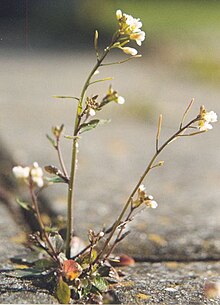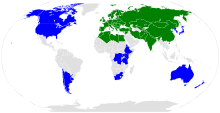阿拉伯芥 (學名:Arabidopsis thaliana 阿拉伯芥 、鼠耳芥 、阿拉伯草 ,是一種原生於歐亞大陸 及非洲 的被子植物 [ 2] [ 3] [ 4] [ 5] [ 6] [ 7] 杂草 [ 8]
拟南芥是一个生命周期相对较短的冬季一年生植物 ,它是植物生物学 和遗传学 领域的流行的模式生物 。对于一个复杂的多细胞真核生物 ,拟南芥有一个相对较小的基因组 ,大约135百萬碱基对 (Mbp)[ 9] 分子生物学 工具,包括花 的发育和向光性 。
在实验室作为模式生物种植的拟南芥 植物学家和生物学家在1900年代初期开始研究拟南芥,1945年前后首次对突变体进行了系统描述[ 10] 植物科学 ,包括遗传学 ,进化 ,种群遗传学,和植物发育研究中[ 11] [ 12] [ 13] 遗传 、细胞 、分子生物学 的一个有用的模式生物 。其在农业科学中所扮演的角色正仿佛小鼠 和果蝇 在人类生物学中的一样。
拟南芥基因组 之小有利于基因定位 和测序 。其基因组大约为12,500万碱基对 和5对染色体 ,在植物中算是小的。在2000年,拟南芥成为第一个基因组被完整测序的植物。[ 14] 基因 的功能上已作出了非常多的工作。[ 15]
植株之小与生活周期之短同样也是拟南芥的优点。实验室常用的许多品系,从萌芽到种子成熟,大约为六个星期。植株之小方便其在有限的空间內培养,而单个植株能产生几千个种子 。此外,其自花传粉 的机制也有助于遗传实验。 所有这些都使拟南芥成为遗传研究的模式生物 。
最后,利用根瘤农杆菌 把DNA 转化进拟南芥基因组已是常规操作。而现在利用“花序浸渍法”(floral-dip)进行转化并不涉及组织培养 和植株再生。
本物種最早期的描述於1577年,當時在德國图林根 诺德豪森 (當時屬於韋廷家族恩斯特系諸邦國 )的一位醫生和植物學家Johannes Thal (德语 ) (1542–1583)描述了一株在哈茨山 的植株,並稱之為Pilosella siliquosa 。1753年,卡尔·林奈 將植株重新命名為Arabis thaliana ,以紀念Thal。1842年,德國植物學家Gustav Heynhold 建立了新的Arabidopsis 属 。這個新屬的名稱源於希腊语 的Arabidopsis 南芥属 物種相似的」。
1873年,亚历山大·布朗第一次用文献记录了拟南芥的突变体 。然而,直到1943年,拟南芥作为模式生物的潜能才有文献记录。[ 16] 克隆 分离出来。[ 17]
数千个拟南芥天然近交种质(accessions)从整个自然和引进的范围内已经被收集[ 18] [ 18]
拟南芥已被廣泛作為花的發育模型之研究。1991年,恩里科·科恩 和埃利奥特·迈耶罗维茨 总结了金鱼草及拟南芥中的经典遗传实验结果,提出了被子植物花器官发育的经典ABC模型 [ 19] 萼片 和花瓣),B类基因(影响花瓣和雄蕊),C类基因(影响雄蕊和心皮 )。这些基因编码转录因子 ,在开发过程中结合在其各自的区域中导致组织规格。虽然通过拟南芥花發育的研究,但这种模式一般适用于其他开花植物 。
感光光敏色素 A,B,C,D和E介导的红色光为基础的向光性反应。理解这些受体的功能,帮助植物生物学家理解调节光週期 ,萌发 ,黃化現象 ,和避荫的植物信号传导级联。
UVR8 UV-B 光并排解响应这种DNA损伤的波长。
拟南芥被广泛用于向光性 ,叶绿体 定位,气孔 开度和其他受蓝光影响的过程的遗传基础研究[ 20]
理解植物如何抵抗保护世界粮食生产以及农业是非常重要的。已经开发了许多模型系统以更好地理解植物与细菌 ,真菌 ,卵菌 ,病毒 和线虫 病原体之间的相互作用。拟南芥一直是植物病理学 研究的有力工具,也就是植物与致病病原体 之间的相互作用。
^ Warwick SI, Francis A, Al-Shehbaz IA. Brassicaceae species checklist and database . Species 2000 & ITIS Catalogue of Life 26. 2016 [2021-06-30 ] . ISSN 2405-8858 存档 于2018-12-09). ^ Arabidopsis thaliana Germplasm Resources Information Network (GRIN). USDA . ^ Hoffmann MH. Biogeography of Arabidopsis thaliana (L.) Heynh. (Brassicaceae) . Journal of Biogeography. 2002, 29 : 125–134. doi:10.1046/j.1365-2699.2002.00647.x ^ Mitchell-Olds T. Arabidopsis thaliana and its wild relatives: a model system for ecology and evolution . Trends in Ecology & Evolution. 2001-12, 16 (12): 693–700. doi:10.1016/s0169-5347(01)02291-1 ^ Sharbel TF, Haubold B, Mitchell-Olds T. Genetic isolation by distance in Arabidopsis thaliana: biogeography and postglacial colonization of Europe . Molecular Ecology. 2000, 9 (12): 2109–2118. PMID 11123622 S2CID 1788832 doi:10.1046/j.1365-294x.2000.01122.x ^ Krämer U. Planting molecular functions in an ecological context with Arabidopsis thaliana . eLife. March 2015, 4 : –06100. PMC 4373673 PMID 25807084 doi:10.7554/eLife.06100 ^ Durvasula A, Fulgione A, Gutaker RM, Alacakaptan SI, Flood PJ, Neto C, Tsuchimatsu T, Burbano HA, Picó FX, Alonso-Blanco C, Hancock AM. Arabidopsis thaliana . Proceedings of the National Academy of Sciences of the United States of America. 2017-05, 114 (20): 5213–5218. PMC 5441814 PMID 28473417 doi:10.1073/pnas.1616736114 (英语) . ^ Jaime Chambers. A widely studied lab plant has revealed a previously unknown organ . ScienceNews . 2021-06-15 [2021-06-30 ] . (原始内容存档 于2021-09-28) (英语) . ^ Genome Assembly . The Arabidopsis Information Resource. [29 March 2016] . (原始内容存档 于2021-03-07). ^ [1] (页面存档备份 ,存于互联网档案馆 ) TAIR: About Arabidopsis ^ Rensink WA, Buell CR. Arabidopsis to Rice. Applying Knowledge from a Weed to Enhance Our Understanding of a Crop Species . Plant Physiol. 2004, 135 (2): 622–9. PMC 514098 PMID 15208410 doi:10.1104/pp.104.040170 ^ Coelho SM, Peters AF, Charrier B, et al. Complex life cycles of multicellular eukaryotes: new approaches based on the use of model organisms. Gene. 2007, 406 (1–2): 152–70. PMID 17870254 doi:10.1016/j.gene.2007.07.025 ^ Platt A, Horton M, Huang YS, Li Y, Anastasio AE, et al. Novembre J , 编. The Scale of Population Structure in Arabidopsis thaliana . PLOS Genetics. 2010, 6 (2): e1000843 [2017-12-31 ] . PMC 2820523 PMID 20169178 doi:10.1371/journal.pgen.1000843 存档 于2014-10-16). ^ The Arabidopsis Genome Initiative. Analysis of the genome sequence of the flowering plant Arabidopsis thaliana. Nature. 2000, 408 : 796–815. PMID 11130711 doi:10.1038/35048692 ^ Integr8 - A.thaliana Genome Statistics: . [2008-11-24 ] . (原始内容存档 于2012-06-08). ^ E.M. Meyerowitz. Prehistory and History of Arabidopsis Research . Plant Physiology. 2001, 125 : 15–19 [2008-11-24 ] . PMID 11154286 doi:10.1038/346035a0 存档 于2009-11-30). ^ M.F. Yanofsky, H. Ma, J.L. Bowman, G.N. Drews, K.A. Feldmann & E.M. Meyerowitz. The protein encoded by the Arabidopsis homeotic gene agamous resembles transcription factors . Nature. 1990, 346 : 35–39 [2008-11-24 ] . PMID 1973265 doi:10.1038/346035a0 存档 于2017-07-22). ^ 18.0 18.1 1001 Genomes Consortium. 1,135 Genomes Reveal the Global Pattern of Polymorphism in "Arabidopsis thaliana" . Cell. 2016, 166 (2): 481–491. doi:10.1016/j.cell.2016.05.063 ^ Enrico S. Coen; Elliot M. Meyerowitz. The war of the whorls: Genetic interactions controlling flower development. Nature. 1991, 353 (6339): 31–37. Bibcode:1991Natur.353...31C PMID 1715520 doi:10.1038/353031a0 ^ Sullivan JA, Deng XW. From seed to seed: the role of photoreceptors in Arabidopsis development. Dev. Biol. 2003, 260 (2): 289–97. PMID 12921732 doi:10.1016/S0012-1606(03)00212-4
Arabidopsis thaliana Arabis thaliana


